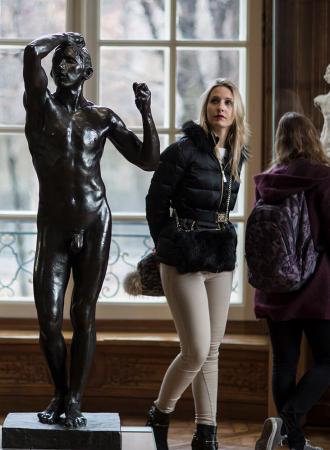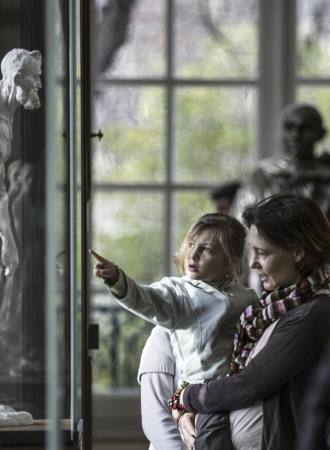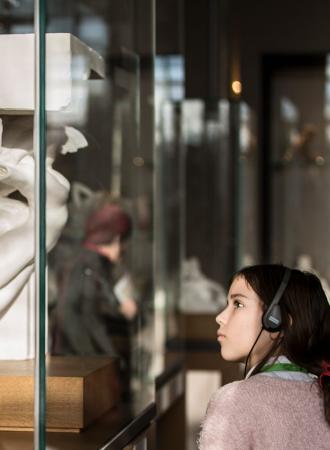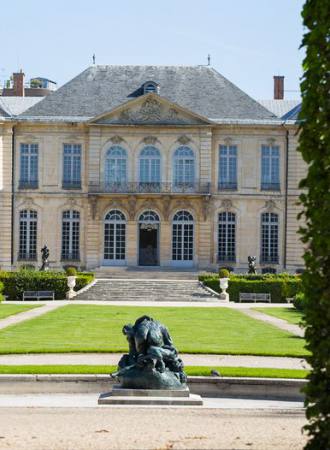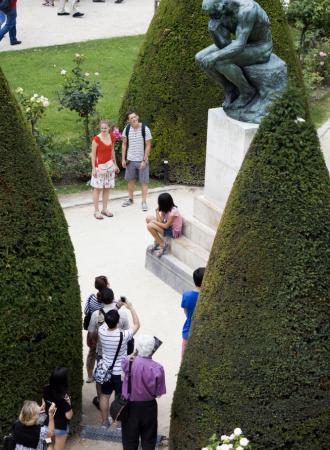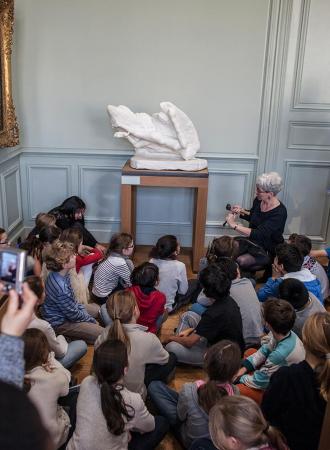Search the site
Rodin and modernism
EARLY ISOLATION
In the 1870s and 1880s, the most innovative Parisian painters often used to meet: Monet, Bazille, Sisley and Renoir in Charles Gleyre’s studio; Monet, Pissaro and Cézanne at the Académie Suisse. Artists and writers also gathered at the homes of Edmond de Goncourt, Berthe Morisot and Eugène Manet. Several works of art testify to the importance of these networks of friends: Fantin-Latour’s Studio in Batignolles (1869, Musée d’Orsay), or Bazille’s Studio in the Rue Condamine (1870, Musée d’Orsay).
Rodin, who in his youth had hesitated between becoming a painter or sculptor had always been interested in the painting of his period. Though a contemporary of the generation of Impressionist painters (he was born within a couple of days of Monet), he did not move in the same circles. Several reasons may explain Rodin’s relative isolation from the Parisian art world in the early stages of his career: he attended the École Impériale Spéciale de Dessin et de Mathématiques, called the “Petite École” to distinguish it from the École des Beaux-Arts, where students often forged strong friendships while training. Whereas most groups of friends were painters, since painting was what interested art critics most in the 1870s, Rodin was a sculptor. Furthermore, he spent several years in Brussels working with Carrier-Belleuse, which meant that he was physically cut off from Parisian circles. Like Rodin, and unlike painters, few sculptors were truly independent: during this period, they were usually employed in ornamental sculpture workshops and had no time to think about forming coteries or societies as their counterparts in painting used to do.
RODIN’S FIRST CIRCLE OF FRIENDS
In the early 1880s, as a result of major commissions received from the French government, Rodin’s growing reputation began to open doors and broaden his circle of friends.
From 1881, Rodin frequented “salons” held by Juliette Adam (from 1881) and the Ménard-Dorians (from 1883). His friends’ wives were often artists themselves: Marie Bracquemond (painter), Marie Cazin and Charlotte Bernard (sculptresses).
Circa 1886, Rodin obtained greater recognition as an artist as his works were seen by an increasingly wider public: the plaster version of The Kiss was shown at the Paris Salon; the different phases of his work on The Burghers of Calais were recorded in photographs taken by Bodmer and Pannelier ;and the sculptor became acquainted with the art critics Gustave Geffroy, Roger Marx, Léon Cladel and Octave Mirbeau, a staunch supporter of Monet, Cézanne, Pissarro, Van Gogh and Gauguin.
In 1887, when taking part in the group exhibitions held in Georges Petit’s gallery, he befriended Renoir, Pissarro, Sisley, Whistler and Monet. Yet that did not make him an Impressionist sculptor, especially since he continued to mix with artists from widely different backgrounds, who were not, strictly speaking, all avant-garde painters, even if each of them proclaimed their modern sensibility. Rodin used to meet up at the Café Américain with a group of friends jokingly known as “Les Pris de Rhum”, namely the writers William E. Henley and Louis de Fourcauld, sculptors Jules Desbois and Jules Dalou, the history painter Jean-Paul Laurens, the realist painters Léon Lhermitte and Alphonse Legros, and the naturalists Jean-Charles Cazin, Jules Bastien-Lepage and Alfred Roll (former “Petite Ecole” student).
To coincide with the 1889 Universal Exposition, Monet, with whom Rodin had made friends c.1886 at Mirbeau’s dinner parties, asked the sculptor to team up with him in an exhibition at Georges Petit’s gallery. The show was a success, despite the problems involved in mounting it that Monet found so disheartening: Rodin was snowed under with commissions for monuments and had to employ new assistants to help him, including Camille Claudel, François Pompon and, in 1893, Antoine Bourdelle.
Thanks to Zola, whom he probably met in the mid-1880s and with whom he shared a common interest in naturalism, Rodin was awarded a commission for a monument to Balzac in 1891. He asked the photographer Nadar to lend him all the relevant documentary material that he kept in his archives – especially the portraits used to illustrate an article by Louis-Auguste Bisson entitled “Balzac and the daguerreotype”, published in 1842. The scandal that erupted in 1898, when the Société des Gens de Lettres rejected Rodin’s Balzac, provides a measure of Parisian artists and intellectuals’ admiration for the sculptor, who received support from writers and critics such as Anatole France, Gustave Geoffroy, Octave Mirbeau, Matthias Morhardt, Georges Rodenbach and Paul Valéry, the artists Antoine Bourdelle, Eugène Carrière, Aristide Maillol, Claude Monet, Paul Signac and Henri de Toulouse-Lautrec, the composer Claude Debussy and the banker and patron of arts Albert Kahn…
In autumn 1899, Bourdelle, Desbois and Rossi founded the Institut Rodin, an academy on Boulevard Montparnasse that soon had thirty students, including Clara Westhoff, the sculptress and future Mrs Rilke. Regardless of its success, the institute closed in April 1900, since Rodin was caught up in the preparations for his large exhibition in the Pavillon de l’Alma and could no longer spare the time for classes.
RODIN, WHISTLER AND ENGLAND
In 1898, backed by James Whistler, then president of the International Society of Painters, Sculptors and Gravers, William Rothenstein, who had met Rodin in 1897, launched a subscription to buy a Saint John the Baptist, now in the Victoria & Albert Museum, London. Contributors included the painters Alphonse Legros, John Tweed and John Singer Sargent… whom Rodin soon dined with at the banquet given in his honour at the Café Royal.
On Whistler’s death in 1903, Rodin succeeded him as president. While The Thinker was on view in London, Rodin received several commissions from English patrons for portrait busts. He was also asked to design the monument to Whistler, and, in 1905, decided to use a female figure for the muse who inspired the artist he had admired so much. The model was a young Welsh painter called Gwen John, who had worked with the American artist.
![Auguste Rodin, Muse Whistler nue, bras coupés, 1908, [S.3005]](/sites/default/files/2021-01/1278oeu_1bd9350ef163233.jpg)
AMERICA
In the early 1880s, when the New York writer William C. Brownell was staying in Paris, he paid a visit to Rodin’s studio. Intrigued by his work, he wrote an article about the sculptor that was published in an American periodical, Century Magazine, in 1889. Other American artists confirmed their interest in his work that same year. Truman Bartlett (sculptor, like his son Paul, and professor at the Massachusetts Institute of Technology), who had met Rodin in Paris two years previously, wrote a series of articles about him in a Boston review. These first links forged with the United States developed into something far more concrete in 1892. Sarah Tyson Halowell, who promoted French art in America by regularly showing the works of Degas, Pissarro and Monet alongside those of the English painters Whistler and Singer Sargent, was in charge of organizing a large exhibition of French art to be held the following year as part of the World Columbian Exposition, in Chicago. The sculptures that Rodin submitted to the show offended the puritanical elements of American society, but attracted the attention of collectors who read about the scandal in the press.
This interest in his work across the Atlantic led to Rodin being introduced to other Americans. Thanks to his friendship with Edward Steichen, a group of his drawings were shown at the 291 Gallery, New York, run by Alfred Stieglitz, in 1908. In 1915, the dancer Loie Fuller, who had been friends with Rodin (like Isadora Duncan) since 1898, used her influence to obtain an exhibition of his works in San Francisco. The sculptor’s final consecration, in 1912, was a gallery reserved for his works alone at the Metropolitan Museum of Art, New York, while the Rodin Museum, in Philadelphia, was founded by a collector in 1929.
TURN OF THE CENTURY - EUROPE AND THE SEZESSION PAINTERS
In 1899, a series of exhibitions of Rodin’s works were held in Brussels, Rotterdam, Amsterdam and The Hague. Despite the fact that when he was in Amsterdam, Rodin preferred to go and see the Rembrandts in the museums rather than visit the studios of the artists on the committee who had invited him, the sculptor’s works were greeted with enthusiasm.
The following year, the Paris Universal Exposition, at which Balzac and The Kiss were shown, and above all the exhibition at the Pavillon de l’Alma, brought him even greater renown. Rodin’s pavilion was visited by people from all over the world: the Irish-born writer Oscar Wilde; the American photographer Edward Steichen; Jolka Rosen, a Danish painter living in Fontainebleau; a Czech painter and writer, who published an article in a Czech periodical and planned an exhibition in Prague, which took place in 1902. Rodin’s attendance made it all the more successful (Butler p. 213). It was visited by “lots of Germans,” as Rodin remarked, including the sculptor Max Klinger, the art historian and professor Paul Clemens, the philosopher Georg Simmel, who would later write an essay entitled “Michangelo and Rodin”, and Rudolf Kasner from Vienna. Several collectors also attended: Dr Linde from Lübeck, who bought an Eve and The Awakening Man. The Danish collector Jacobsen purchased six works; an American living in Britain bought a marble version of The Kiss.
Many of the people who visited the Parisian exhibition in the Pavillon de l’Alma also went to see Rodin in Meudon. Among these artists, intellectuals and collectors were several well-known personalities: the writers Arthur Symons, George Moore et George Bernard Shaw, who would pose for his bust in 1906, accompanied by the American photographer Alvin Langdon Coburn ; Rainer Maria Rilke, who became a regular face around Meudon from 1902 and would write a monograph on Rodin; and, in 1905, the writer Stefan Zweig, the photographer Gertrude Käsebier, to name just a few.
Rodin’s successful participation at the Sezession exhibitions in Vienna (1897) and Berlin (1899), as well as the International Art Exhibition in Dresden (1901), enthralled the German avant-garde, who regarded him, to quote the painter and etcher Max Liebermann, as “the only genius amongst contemporary French artists”.
RODIN AND THE NEW GENERATION OF SCULPTORS
For many young artists, Rodin’s exhibition in 1900 proved that sculpture, like painting, was open to experimentation. Maillol’s experiments with modelling date from then, while Despiau, who had been in Paris since 1850, saw Rodin as a true “spiritual father” and began to develop a more personal style. The Spanish sculptors Gonzalez and Manolo, newcomers to the French capital, underwent a “Rodinesque” phase before developing their own style, like Picasso who, together with the painter Zuloaga (also a friend of Rodin who owned one of his paintings ), probably visited the exhibition at the Pavillon de l’Alma.
Vue de l'oeuvre
Matisse first met Rodin in 1899. On the advice of a friend who worked for Rodin, Matisse decided to go and show his drawings to the sculptor: “I showed my drawings to Rodin, who told me, ‘Drawing comes easily to you. You must be wary of that. You have to do extremely precise drawings, finicky even, with as many details as possible, and once you’ve done some like that, show them to me.’ I left Rodin’s feeling more disappointed than flattered, thinking that he should have taught me something.” Having attended the Académie Julian and the Académie Camillo, where the pupils were supervised by Carrière, Matisse frequented the ephemeral Institut Rodin in 1900. He grew closer to Antoine Bourdelle and began attending sculpture classes at the Académie de la Grande Chaumière. In 1900, although he was still a penniless young artist, he purchased a plaster of Rodin’s Bust of Rochefort from Vollard. He no doubt visited the Pavillon de l’Alma exhibition that same year. The first large clay figure produced by Matisse, The Serf (1900-03), clearly seems to have drawn its inspiration from The Walking Man, then entitled Study for Saint John the Baptist.
Despite their rather frosty first encounter, Matisse attended the dinner in Rodin’s honour at the Closerie des Lilas, Paris, to which the painters Charles Camoin and Henri Manguin were also invited. Rodin lent Matisse his three Van Goghs (two landscapes and Père Tanguy, for the painter’s retrospective organized by the Salon des Artistes Indépendants in 1905.
In 1904, almost certainly spurred on by the reputation that Rodin had acquired in Eastern Europe following his appearance at the various Sezession exhibitions, the Romanian sculptor Constantin Brancusi travelled across Europe – on foot so the legend claims – to meet him in Paris. Although very much impressed by Rodin, he only stayed a few weeks in his studio, convinced that he had to free himself of his influence: “No other tree can grow in the shadow of a great oak,” he reputedly declared. Until the early 1910s, Brancusi’s sculpture remained in the same vein as Rodin’s. He soon realized that he could only follow his own path if he abandoned modelling, the technique in which Rodin excelled, and turned to the age-old technique of carving stone or wood. And yet, his tributes to Rodin, The Kiss and The Gate of the Kiss, are among his most emblematic works.
In 1905, the Fauves were the latest group of painters to be causing an uproar in the Parisian art world, followed, in 1910, by the Cubists. Several exponents of these two trends were, however, influenced by Rodin’s works at some point in their career. His lasting impact also made itself felt in modern sculpture in other European countries, notably in Germany (Clara Westhoff, Wilhelm Lehmbruck), Lithuania (Jacques Lipchitz) and Russia (Ossip Zadkine, Alexander Archipenko)…
BIBLIOGRAPHY
- Alain Beausire, Quand Rodin exposait, éditions du Musée Rodin, Paris, 1988.
- Ruth Butler, Rodin: The Shape of Genius, Yale University Press, New Haven and London, 1993.
- Pierre Daix, Rodin, Calmann-Lévy, Paris, 1988 (particularly the chapters “Vers la modernité?”, p. 125, and “La gloire et la modernité”, p. 203).
- Matisse & Rodin, exhibition catalogue, éditions du Musée Rodin, Paris, 2009 (particularly Nadine Lehni, “Matisse et Rodin: une passion pour le dessin”, p. 61).
- Rodin et la sculpture contemporaine, conference proceedings, Musée Rodin, 1982 (notably Claudie Judrin, “Rodin et les peintres de son temps”, p. 51).
